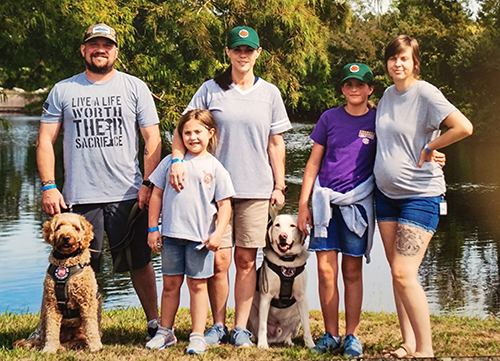
Are Your Tenants Safe?
Spontaneous assistance techniques
Vision impairments
When assisting people with vision impairments there are some basic rules to follow in order to be effective.
- Announce oneself; speak out when entering the work area.
- Speak naturally and directly to the individual and NOT through a third party. Do not shout.
- Don't be afraid to use words like "see," "look" or "blind."
- Offer assistance but let the person explain what help is needed.
- Describe the action to be taken in advance.
- Let the individual grasp an arm or shoulder lightly for guidance. He/she may choose to walk slightly behind the individual providing assistance; be sure to mention stairs, doorways, narrow passages, ramps, etc.
- When guiding to a seat, place the person's hand on the back of the chair.
- If leading several individuals with visual impairments at the same time, ask them to hold each other's hands.
- After exiting the building, ensure that individuals with impaired vision are not "abandoned," but are led to a place of safety where a colleague should remain with them until the emergency is over. Another of the lessons learned from the World Trade Center incident: Blind tenants complained after being escorted out of the building and unceremoniously left in unfamiliar environs outside in the midst of a winter ice storm. There, they had to negotiate ice-covered sidewalks and falling glass from overhead.
Suggestions when assisting owners of dog guides
- Do not pet or offer the dog food without the permission of the owner.
- When the dog is wearing its harness, it is on duty. If circumstances dictate that the dog is not supposed to guide its owner, ask the owner to remove the dog's harness.
- Plan for the dog to be evacuated with the owner.
- In the event you are asked to take the dog while assisting the individual, hold the leash and not the dog's harness.
Hearing impairments
When assisting people with hearing impairments, there are also some things to keep in mind. These include:
- Flick the lights when entering the work area to get the person's attention.
- Establish eye contact with the individual, even if an interpreter is present.
- Face the light, do not turn away, and never chew gum.
- Use facial expressions and hand gestures as visual cues.
- Check to see if the person understands, and repeat if necessary.
- Offer pencil and paper. Write slowly, and let the individual read as the message is written. Written communication may be especially important if the individual's speech is difficult to understand.
- Do not allow others to interrupt or joke with you while conveying the emergency information.
- Be patient, the individual may have difficulty comprehending the urgency of your message.
- Provide the individual with a flashlight for signaling his or her location in the event that he or she is separated from the rescuing team or "buddy," and to facilitate lip-reading in the dark.
Learning disabilities
People with learning disabilities may have difficulty in recognizing or being motivated to act in an emergency by untrained rescuers. They may also have difficulty in responding to instructions that involve more than a small number of simple actions. Some suggestions for assisting such people include:
- The person's visual perception of written instructions or signs may be confused.
- The person's sense of direction may be limited, requiring someone to accompany them.
- Directions or information may need to be broken down into simple steps. Be patient.
- Simple signals and/or symbols should be used (similar to the graphics used throughout this section).
- The person's ability to understand speech is often more developed than his/her own vocabulary. Do not talk about a person to others in front of him/her.
- The individual should be treated as an adult who happens to have a cognitive or learning disability. Do not talk down to them or treat them like children.








 “Streaming is both accessible and not accessible,” Evans said. “The streaming part itself is accessible, in that it allows me to make my own schedule, and I can work it around my disabilities. However, the inaccessible part is the demand for content creators to constantly be networking, attending events and continuously pushing out content. I cannot attend events, and if I can they’re incredible stressful, so all my work networking has basically been done online, which thankfully is becoming a more acceptable side of content creation.”
“Streaming is both accessible and not accessible,” Evans said. “The streaming part itself is accessible, in that it allows me to make my own schedule, and I can work it around my disabilities. However, the inaccessible part is the demand for content creators to constantly be networking, attending events and continuously pushing out content. I cannot attend events, and if I can they’re incredible stressful, so all my work networking has basically been done online, which thankfully is becoming a more acceptable side of content creation.” “I must say over the years it has become less and less accessible for me,” Martínez said. “SMA (Spinal Muscular Atrophy) causes strength, endurance and mobility loss as time passes. I can’t use a physical keyboard as I used to, so it’s been years now with an on-screen keyboard. Voice dictation doesn’t work well for me due to my voice being inconsistent, not to mention my accent. In English it can go from totally wrong to acceptable. In Spanish, my native language, it works better.”
“I must say over the years it has become less and less accessible for me,” Martínez said. “SMA (Spinal Muscular Atrophy) causes strength, endurance and mobility loss as time passes. I can’t use a physical keyboard as I used to, so it’s been years now with an on-screen keyboard. Voice dictation doesn’t work well for me due to my voice being inconsistent, not to mention my accent. In English it can go from totally wrong to acceptable. In Spanish, my native language, it works better.” “What drew me to consulting was the opportunity to leverage my unique perspective as both an able-bodied and disabled gamer to improve the gaming experience for others,” Lane said. “I can share the frustrations I’ve faced as a disabled gamer and use that knowledge to advocate for better accessibility features. Companies and studios that I work with go the extra mile to make sure I have everything I need to succeed.”
“What drew me to consulting was the opportunity to leverage my unique perspective as both an able-bodied and disabled gamer to improve the gaming experience for others,” Lane said. “I can share the frustrations I’ve faced as a disabled gamer and use that knowledge to advocate for better accessibility features. Companies and studios that I work with go the extra mile to make sure I have everything I need to succeed.”



Connect with us on social media